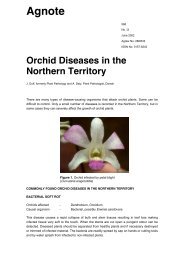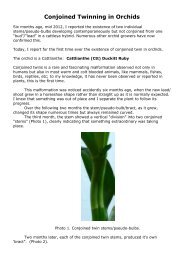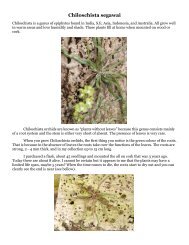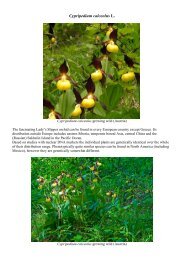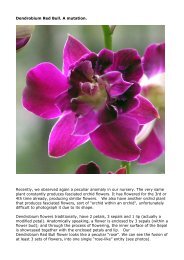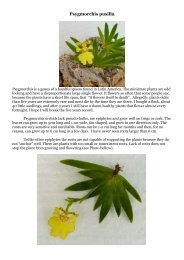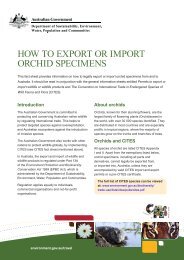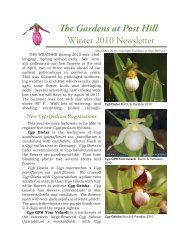P + M + S - Orchids-World
P + M + S - Orchids-World
P + M + S - Orchids-World
Create successful ePaper yourself
Turn your PDF publications into a flip-book with our unique Google optimized e-Paper software.
mother plant for support. In nature, in most cases the “mother plant” in its effort to support its<br />
own offspring (keikis) soon or later will die. It fulfilled the purpose of a life form: Born – Multiply<br />
– Die.<br />
There are hundreds of other examples.<br />
The two terrestrials I mentioned at the beginning are Serapia and Pterygodium. Other similar<br />
genera are: Pterostylis, Diuris, Thelymitra, Leptoceras, Corybas, etc. In all these orchids:<br />
1. One little tuber produces one single self-standing, self-sufficient plant, never<br />
two. (Monostemic)<br />
2. The plant will die slowly after flowering and in most cases the tuber will<br />
shrivel and die.<br />
3. The roots MAY form one or more tubers. These tubers are not connected to<br />
the main tuber and therefore to the plant it self and are not capable of<br />
producing a “shoot” straight away (the same year).<br />
4. The string-like root that connects the new tubers will die during the dormant<br />
period and the tubers will also mature during that time.<br />
5. When the new growth season starts autumn or spring, the now independent<br />
tubers will produce a single plant each.<br />
6. Each plant will be on its own, have its own root system, etc. (New life cycle)<br />
These orchids fulfil the requirements of a monopodial plant and were monopodial 250 years ago.<br />
Today, they are sympodial because they are annuals and because the flower spike is terminal.<br />
Off course, there are terrestrial orchids like Eulophia that are sympodial. They have<br />
pseudo-bulbs and not tubers. The pseudo-bulbs are in some species visible above the ground and<br />
other species hidden underground. They grow the same way sympodial orchids grow. New<br />
pseudo-bulbs are attached to existing older pseudo-bulbs and continue to feed and receive<br />
support from them. These orchids can be propagated by division.<br />
Isn’t it time to say what we mean and mean what we say?<br />
Dr. George Tsambourakis,<br />
Gold Coast, Queensland, Australia.



